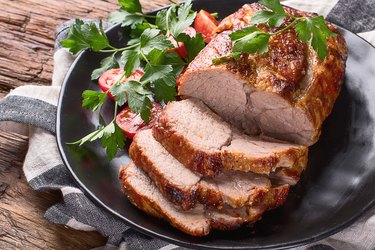
Are you worried that you might serve up a side of food poisoning at your next barbecue? Pork definitely needs to be cooked through for food safety, but cook it for too long, and you might as well serve a piece of leather. Finding the sweet spot of cooked enough without drying out your pork is key.
Dangers of Undercooked Pork
Video of the Day
Why does it matter if your pork isn't quite done? People eat steak that's still practically raw, and they're fine. However, pork comes with unique concerns in the food safety department.
Video of the Day
If you eat pork that isn't properly cooked, you may expose yourself to Trichnella spiralis. That's a fancy name for the parasitic worms that can be in pork. They can cause trichinosis.
This disease has the potential to cause all sorts of problems, including fever, nausea and abdominal pain. In severe cases, it can cause facial swelling and even death. It's not as common these days, but even a slight risk is a good-enough reason to make sure your pork is fully cooked.
Using a Meat Thermometer
Temperature is the most reliable indicator of pork doneness. The meat needs to reach a safe temperature to kill all the potential causes of foodborne illness. Checking the temperature with a meat thermometer is the only guaranteed way to know that it reached that safe zone.
So, what temperature does your pork need to reach? The recommended internal temperature is 145 degrees Fahrenheit for muscle meats and 160 F for ground pork as measured by a meat thermometer. Pork's internal temperature keeps going up shortly after you stop cooking it, so you can pull it out when it passes 140 F. Just make sure it hits 145 F before eating it.
You can use a continuous-read thermometer, which stays inserted in the pork while it cooks, or an instant-read thermometer that you insert to check the temperature at the end of the cooking time. Continuous-read thermometers work best on pork that's at least 1-inch thick to keep the probe in place. With either type of thermometer, insert the probe into the thickest part, away from any bones.
Checking the Texture
A less-reliable way to check pork doneness is by feeling the texture of the meat. When it's done, the pork should be firm and springy. If you press on it with your finger, it should pop back up instantly. It's often compared to how the palm of your hand feels when you stretch out your fingers.
Cutting Into the Pork
Another hit-or-miss way to check pork doneness without a meat thermometer is by cutting into it and using visual clues. Any juice coming from the pork should look clear. If it's not clear, the pork needs more cooking time.
The internal color can be tricky to assess. You've probably heard that pork shouldn't be pink in the middle, but some pork may have a little pink inside even after it reaches the safe temperature. If it's mostly pink, though, or you can see a clear, white cooked section along the outside with a dark-pink middle, then it needs more time to heat.
As you cut into the pork, note whether it feels tough or tender inside. When it's fully cooked, pork should be more tender than it was when it was raw. Test this easily without cutting the meat by inserting a knife or skewer and feeling for resistance.